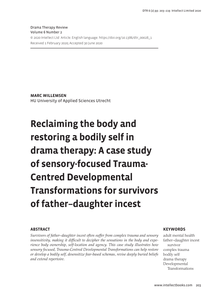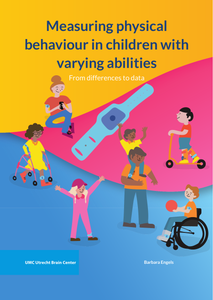In order to optimize collaboration between Speech and Language Therapists (SLTs) and parents of children with Developmental Language Disorders (DLD), our aim was to study what is needed for SLTs to transition from the parent-as-therapist aide model to the FCC model and optimal collaborate with parents. Chapter 2 discusses the significance of demystifying collaborative working by making explicit how collaboration works. Chapter 3 examines SLTs’ perspectives on engaging parents in parent-child interaction therapy, utilizing a secondary analysis of interview data. Chapter 4 presents a systematic review of specific strategies that therapists can employ to enhance their collaboration with parents of children with developmental disabilities. Chapter 5 explores the needs of parents in their collaborative interactions with SLTs during therapy for their children with DLD, based on semi-structured interviews. Chapter 6 reports the findings from a behavioral analysis of how SLTs currently engage with parents of children with DLD, using data from focus groups. Chapter 7 offers a general discussion on the findings of this thesis, synthesizing insights from previous chapters to propose recommendations for practice and future research.
DOCUMENT

Developmental Transformations (DvT), a practice involving interactive, improvisational play in pairs or groups, has gained international appeal as a therapeutic intervention for different populations in a variety of health, care and recreational contexts. However, a rigorous review of the benefits of DvT has not been conducted. The purpose of this study was to review extant literature for the observed benefits of DvT, identify gaps in the literature and make recommendations concerning future research including identifying possible areas for outcome measurement for preliminary studies. The authors, who each completed training in this approach, conducted a scoping review of English-language, published, peer-reviewed and grey DvT literature through 2021. From an initial 745 records retrieved through databases and a manual search, 51 publications met criteria, which, when analysed using in-vivo and pattern coding, resulted in a total of seventeen categories of observed benefits ascribed to DvT. These included six general categories – relational, emotional, social, cognitive, behavioural and physical benefits – and eleven complex categories of benefits to participants across the lifespan. In addition to benefits for participants, benefits of DvT were also observed and reported for facilitators, therapists, teachers and supervisors engaged in this practice. This review revealed inconsistencies regarding the reporting of practitioner training, frequency, format, population, intended goals, assessment measures and outcomes. Future studies with increased experimental rigor, standardized outcome measures and consistent reporting are recommended.
DOCUMENT

Survivors of father–daughter incest often suffer from complex trauma and sensory insensitivity, making it difficult to decipher the sensations in the body and experience body ownership, self-location and agency. This case study illustrates how sensory focused, Trauma-Centred Developmental Transformations can help restore or develop a bodily self, desensitize fear-based schemas, revise deeply buried beliefs and extend repertoire.
DOCUMENT

Background Variations in communicative participation of children with developmental language disorder (DLD) cannot be wholly explained by their language difficulties alone and may be influenced by contextual factors. Contextual factors may support or hinder communicative participation in children, which makes their identification clinically relevant. Aims To investigate which contextual (environmental and personal) factors in early childhood are protective, risk or neutral factors for communicative participation among school-aged children with DLD, and to identify possible gaps in knowledge about this subject. Methods & Procedures A scoping review was conducted based on a systematic search of studies published from January 2007 to March 2022 in Pubmed, Embase (without MEDLINE), CINAHL and PsycINFO. In total, 8802 studies were reviewed using predefined eligibility criteria, of which 32 studies were included for data extraction and critically appraised using the Critical Appraisal Skills Programme (2021) tools. Main Contribution The methodological quality of included studies was adequate to strong. Personal protective factors identified are being a preschool girl, reaching school age and being prosocial, while personal risk factors are becoming a teenager or adolescent, having low socio-cognitive skills and experiencing comorbid mobility impairment or behavioural problems. Gender after the preschool years and non-verbal abilities were not found to be of influence, and the role of socio-emotional skills is inconclusive. Receiving therapy is an environmental protective factor, while the association between socio-economical family characteristics with communicative participation is inconclusive. Conclusions & Implications Limited research has been conducted on which risk and protective factors present in early childhood are associated with later communicative participation of children with DLD. The influence of co-occurring health conditions, social background variables, individual psychological assets, interpersonal relationships and attitudes of other people represent knowledge gaps. In addition, knowledge about the comparative effectiveness of different types of interventions and service delivery models, and the impact of administrative control, organizational mechanisms and standards established by governments on children's communicative participation is lacking. More longitudinal research is needed focusing on the identification of relevant personal and environmental factors and the interactions between them in relation to communicative participation outcomes.
LINK
This thesis aims to develop and validate a comprehensive and adaptable activity monitoring system that quantifies physical behaviours in children with and without developmental disabilities, including those utilizing assistive devices. This system seeks to overcome the current limitations in the accuracy and feasibility of existing monitoring devices by providing robust measurements in real-world settings.
MULTIFILE

BackgroundVariations in communicative participation of children with developmental language disorder (DLD) cannot be wholly explained by their language difficulties alone and may be influenced by contextual factors. Contextual factors may support or hinder communicative participation in children, which makes their identification clinically relevant.AimsTo investigate which contextual (environmental and personal) factors in early childhood are protective, risk or neutral factors for communicative participation among school-aged children with DLD, and to identify possible gaps in knowledge about this subject.Methods & ProceduresA scoping review was conducted based on a systematic search of studies published from January 2007 to March 2022 in Pubmed, Embase (without MEDLINE), CINAHL and PsycINFO. In total, 8802 studies were reviewed using predefined eligibility criteria, of which 32 studies were included for data extraction and critically appraised using the Critical Appraisal Skills Programme (2021) tools.Main ContributionThe methodological quality of included studies was adequate to strong. Personal protective factors identified are being a preschool girl, reaching school age and being prosocial, while personal risk factors are becoming a teenager or adolescent, having low socio-cognitive skills and experiencing comorbid mobility impairment or behavioural problems. Gender after the preschool years and non-verbal abilities were not found to be of influence, and the role of socio-emotional skills is inconclusive. Receiving therapy is an environmental protective factor, while the association between socio-economical family characteristics with communicative participation is inconclusive.Conclusions & ImplicationsLimited research has been conducted on which risk and protective factors present in early childhood are associated with later communicative participation of children with DLD. The influence of co-occurring health conditions, social background variables, individual psychological assets, interpersonal relationships and attitudes of other people represent knowledge gaps. In addition, knowledge about the comparative effectiveness of different types of interventions and service delivery models, and the impact of administrative control, organizational mechanisms and standards established by governments on children's communicative participation is lacking. More longitudinal research is needed focusing on the identification of relevant personal and environmental factors and the interactions between them in relation to communicative participation outcomes.
DOCUMENT
Background: Early detection and remediation of language disorders are important in helping children to establish appropriate communicative and social behaviour and acquire additional information about the world through the use of language. In the Netherlands, children with (a suspicion of) language disorders are referred to speech and hearing centres for multidisciplinary assessment. Reliable data are needed on the nature of language disorders, as well as the age and source of referral, and the effects of cultural and socioeconomic profiles of the population served in order to plan speech and language therapy service provision. Aims: To provide a detailed description of caseload characteristics of children referred with a possible language disorder by generating more understanding of factors that might influence early identification. Methods & Procedures: A database of 11,450 children was analysed consisting of data on children, aged 2–7 years (70% boys, 30% girls), visiting Dutch speech and hearing centres. The factors analysed were age of referral, ratio of boys to girls, mono‐ and bilingualism, nature of the language delay, and language profile of the children. Outcomes & Results:Results revealed an age bias in the referral of children with language disorders. On average, boys were referred 5 months earlier than girls, and monolingual children were referred 3 months earlier than bilingual children. In addition, bilingual children seemed to have more complex problems at referral than monolingual children. They more often had both a disorder in both receptive and expressive language, and a language disorder with additional (developmental) problems. Conclusions & Implications: This study revealed a bias in age of referral of young children with language disorders. The results implicate the need for objective language screening instruments and the need to increase the awareness of staff in primary child healthcare of red flags in language development of girls and multilingual children aiming at earlier identification of language disorders in these children.
DOCUMENT

The principal aim of this study is to explore the relations between work domains and the work-related learning of workers. The article is intended to provide insight into the learning experiences of Dutch police officers during the course of their daily work. Interviews regarding actual learning events and subsequent changes in knowledge, skills or attitudes were conducted with police officers from different parts of the country and in different stages of their careers. Interpretative analyses grounded in the notion of intentionality and developmental relatedness revealed how and in what kinds of work domains police officers appear to learn. HOMALS analysis showed work-related learning activities to vary with different kinds of work domains. The implications for training and development involve the role of colleagues in different hierarchical positions for learning and they also concern the utility of the conceptualisation of work-related learning presented here.
DOCUMENT

Background: Collaboration between Speech and Language Therapists (SLTs) and parents is considered best practice for children with developmental disorders. However, such collaborative approach is not yet implemented in therapy for children with developmental language disorders (DLD) in the Netherlands. Improving Dutch SLTs’ collaboration with parents requires insight in factors that influence the way SLTs work with parents. Aims: To explore the specific beliefs of Dutch SLTs that influence how they collaborate with parents of children with DLD. Methods and procedures: We conducted three online focus groups with 17 SLTs using a reflection tool and fictional examples of parents to prompt their thoughts, feelings and actions on specific scenarios. Data were organised using the Theoretical Domains Framework (TDF). Outcomes and results: We identified 34 specific beliefs across nine TDF domains on how SLTs collaborate with parents of children with DLD. The results indicate that SLTs hold beliefs on how to support SLTs in collaborating with parents but also conflicting specific beliefs regarding collaborative work with parents. The latter relate to SLTs’ perspectives on their professional role and identity, their approach towards parents, and their confidence and competence in working collaboratively with parents.
DOCUMENT

In this chapter it is argued that self-direction is currently well above the head of the majority of youngsters and even of many adults. Evidence for this conclusion stems from developmental and brain research. However, for various reasons it is important that people develop the competences that are necessary for self-direction. To what degree is it possible to develop these competences? Are they 'learnable'? What can education contribute?
DOCUMENT
